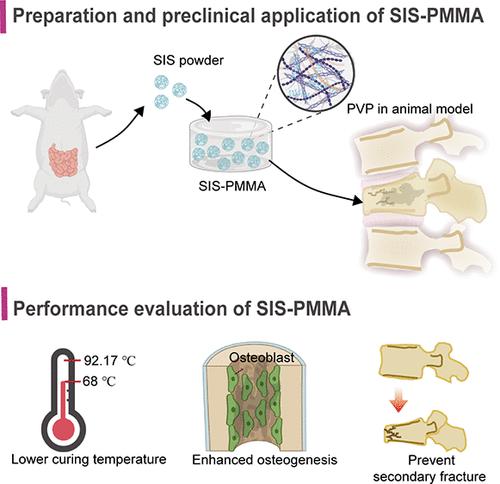当前位置:
X-MOL 学术
›
ACS Biomater. Sci. Eng.
›
论文详情
Our official English website, www.x-mol.net, welcomes your feedback! (Note: you will need to create a separate account there.)
Preclinical Evaluation of Bioactive Small Intestinal Submucosa-PMMA Bone Cement for Vertebral Augmentation
ACS Biomaterials Science & Engineering ( IF 5.8 ) Pub Date : 2024-03-13 , DOI: 10.1021/acsbiomaterials.3c01629 Chi Zhang 1, 2 , Xiongxiong Cai 1 , Mei Li 3 , Jing Peng 2 , Jin Mei 4 , Fangfang Wang 4 , Rui Zhang 4 , Yingjie Zhou 4 , Shuyu Fang 5 , Dongdong Xia 1 , Jiyuan Zhao 2
ACS Biomaterials Science & Engineering ( IF 5.8 ) Pub Date : 2024-03-13 , DOI: 10.1021/acsbiomaterials.3c01629 Chi Zhang 1, 2 , Xiongxiong Cai 1 , Mei Li 3 , Jing Peng 2 , Jin Mei 4 , Fangfang Wang 4 , Rui Zhang 4 , Yingjie Zhou 4 , Shuyu Fang 5 , Dongdong Xia 1 , Jiyuan Zhao 2
Affiliation

|
In vertebroplasty and kyphoplasty, bioinert poly(methyl methacrylate) (PMMA) bone cement is a conventional filler employed for quick stabilization of osteoporotic vertebral compression fractures (OVCFs). However, because of the poor osteointegration, excessive stiffness, and high curing temperature of PMMA, the implant loosens, the adjacent vertebrae refracture, and thermal necrosis of the surrounding tissue occurs frequently. This investigation addressed these issues by incorporating the small intestinal submucosa (SIS) into PMMA (SIS-PMMA). In vitro analyses revealed that this new SIS-PMMA bone cement had improved porous structure, as well as reduced compressive modulus and polymerization temperature compared with the original PMMA. Furthermore, the handling properties of SIS-PMMA bone cement were not significantly different from PMMA. The in vitro effect of PMMA and SIS-PMMA was investigated on MC3T3-E1 cells via the Transwell insert model to mimic the clinical condition or directly by culturing cells on the bone cement samples. The results indicated that SIS addition substantially enhanced the proliferation and osteogenic differentiation of MC3T3-E1 cells. Additionally, the bone cement’s biomechanical properties were also assessed in a decalcified goat vertebrae model with a compression fracture, which indicated the SIS-PMMA had markedly increased compressive strength than PMMA. Furthermore, it was proved that the novel bone cement had good biosafety and efficacy based on the International Standards and guidelines. After 12 weeks of implantation, SIS-PMMA indicated significantly more osteointegration and new bone formation ability than PMMA. In addition, vertebral bodies with cement were also extracted for the uniaxial compression test, and it was revealed that compared with the PMMA-implanted vertebrae, the SIS-PMMA-implanted vertebrae had greatly enhanced maximum strength. Overall, these findings indicate the potential of SIS to induce efficient fixation between the modified cement surface and the host bone, thereby providing evidence that the SIS-PMMA bone cement is a promising filler for clinical vertebral augmentation.
中文翻译:

生物活性小肠粘膜下层-PMMA骨水泥用于椎体增强的临床前评价
在椎体成形术和椎体后凸成形术中,生物惰性聚甲基丙烯酸甲酯 (PMMA) 骨水泥是一种常规填料,用于快速稳定骨质疏松性椎体压缩骨折 (OVCF)。但由于PMMA的骨整合性差、刚度过大、固化温度高等原因,常常会发生植入物松动、邻近椎骨再骨折、周围组织热坏死等现象。本研究通过将小肠粘膜下层 (SIS) 纳入 PMMA (SIS-PMMA) 来解决这些问题。体外分析表明,与原始PMMA相比,这种新型SIS-PMMA骨水泥改善了多孔结构,并降低了压缩模量和聚合温度。此外,SIS-PMMA 骨水泥的操作性能与 PMMA 没有显着差异。通过 Transwell 插入模型模拟临床状况或直接在骨水泥样品上培养细胞,研究 PMMA 和 SIS-PMMA 对 MC3T3-E1 细胞的体外影响。结果表明,SIS的添加显着增强了MC3T3-E1细胞的增殖和成骨分化。此外,还在具有压缩性骨折的脱钙山羊椎骨模型中评估了骨水泥的生物力学性能,这表明 SIS-PMMA 的抗压强度比 PMMA 显着增加。此外,根据国际标准和指南,证明新型骨水泥具有良好的生物安全性和功效。植入12周后,SIS-PMMA显示出比PMMA显着更强的骨整合和新骨形成能力。此外,还提取了骨水泥椎体进行单轴压缩试验,结果表明,与PMMA植入椎骨相比,SIS-PMMA植入椎骨的最大强度大大提高。总体而言,这些发现表明 SIS 具有诱导改性骨水泥表面和宿主骨之间有效固定的潜力,从而提供证据表明 SIS-PMMA 骨水泥是临床椎体增强的有前途的填充剂。
更新日期:2024-03-13
中文翻译:

生物活性小肠粘膜下层-PMMA骨水泥用于椎体增强的临床前评价
在椎体成形术和椎体后凸成形术中,生物惰性聚甲基丙烯酸甲酯 (PMMA) 骨水泥是一种常规填料,用于快速稳定骨质疏松性椎体压缩骨折 (OVCF)。但由于PMMA的骨整合性差、刚度过大、固化温度高等原因,常常会发生植入物松动、邻近椎骨再骨折、周围组织热坏死等现象。本研究通过将小肠粘膜下层 (SIS) 纳入 PMMA (SIS-PMMA) 来解决这些问题。体外分析表明,与原始PMMA相比,这种新型SIS-PMMA骨水泥改善了多孔结构,并降低了压缩模量和聚合温度。此外,SIS-PMMA 骨水泥的操作性能与 PMMA 没有显着差异。通过 Transwell 插入模型模拟临床状况或直接在骨水泥样品上培养细胞,研究 PMMA 和 SIS-PMMA 对 MC3T3-E1 细胞的体外影响。结果表明,SIS的添加显着增强了MC3T3-E1细胞的增殖和成骨分化。此外,还在具有压缩性骨折的脱钙山羊椎骨模型中评估了骨水泥的生物力学性能,这表明 SIS-PMMA 的抗压强度比 PMMA 显着增加。此外,根据国际标准和指南,证明新型骨水泥具有良好的生物安全性和功效。植入12周后,SIS-PMMA显示出比PMMA显着更强的骨整合和新骨形成能力。此外,还提取了骨水泥椎体进行单轴压缩试验,结果表明,与PMMA植入椎骨相比,SIS-PMMA植入椎骨的最大强度大大提高。总体而言,这些发现表明 SIS 具有诱导改性骨水泥表面和宿主骨之间有效固定的潜力,从而提供证据表明 SIS-PMMA 骨水泥是临床椎体增强的有前途的填充剂。



























 京公网安备 11010802027423号
京公网安备 11010802027423号